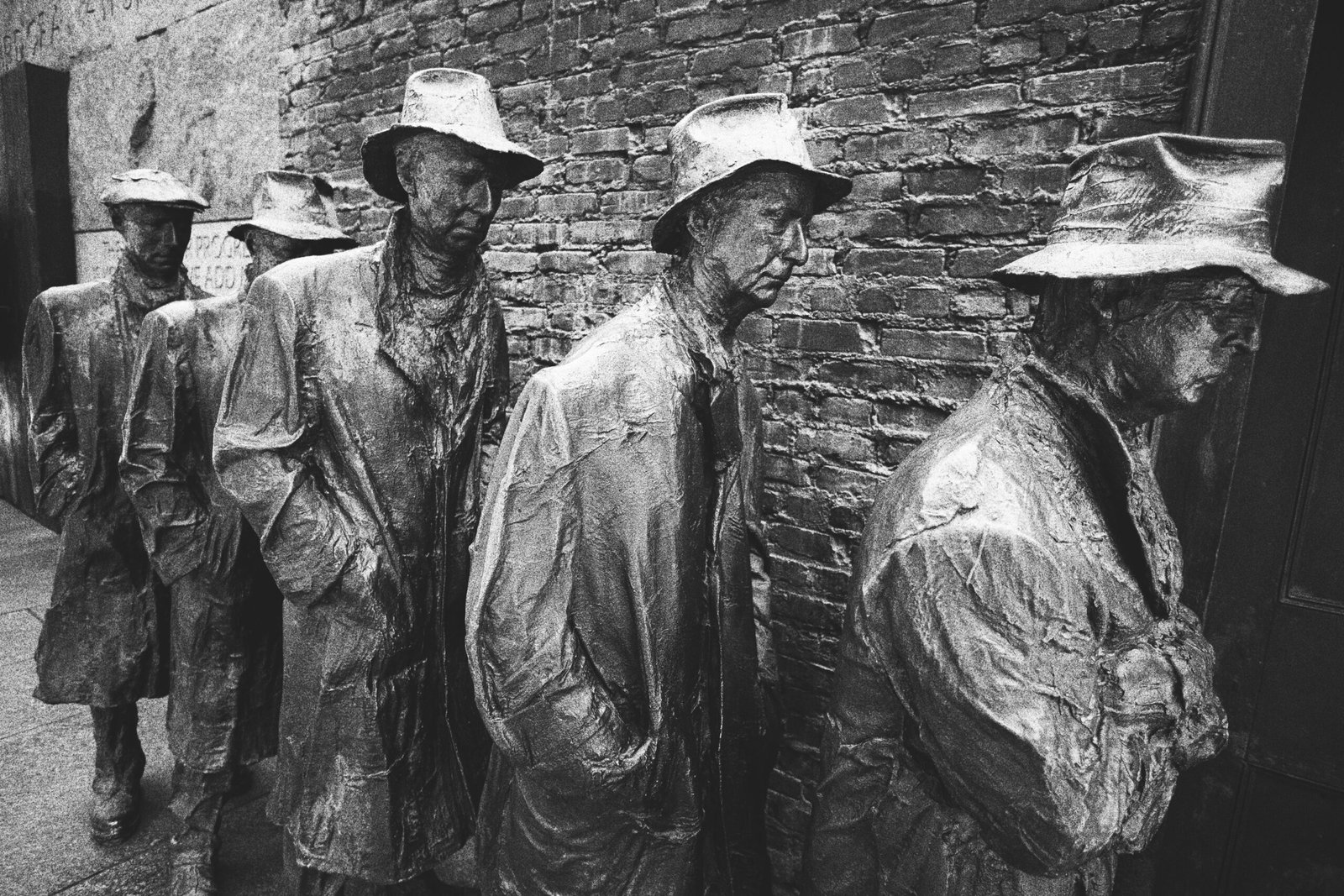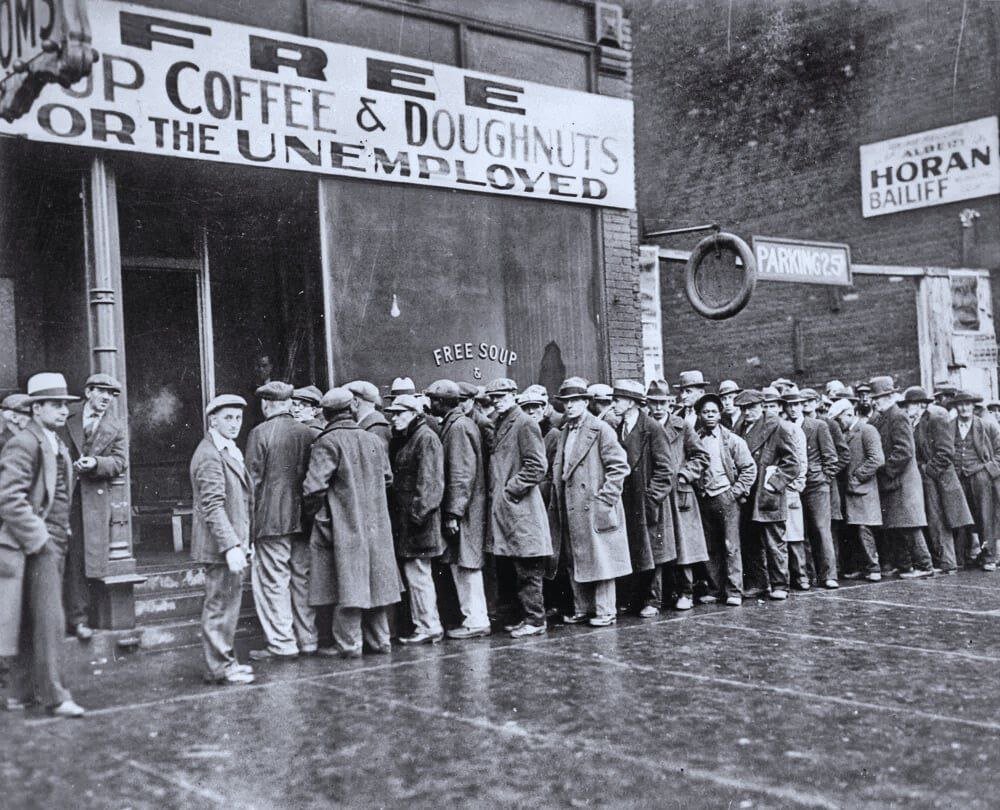
Contents
- Introduction to the Great Depression
- Causes of the Great Depression
- Impact on American Society
- Government Response and New Deal Policies
- Boost in Industrial Production
- Job Creation and Workforce Changes
- Long-Term Economic Changes
- Cultural Impact and Legacy
- Comparisons with Other Economic Crises
- Conclusion and Reflections

Introduction to the Great Depression
The Great Depression stands as a significant chapter in the history of the United States, marking an era of unparalleled economic adversity that spanned from 1929 to the late 1930s, extending into the early 1940s. This period was characterized by a severe and prolonged economic downturn that began with the notorious stock market crash of October 1929, often referred to as Black Tuesday. The crash precipitated a chain reaction of financial failures, leading to widespread unemployment, drastic declines in industrial output, and a pervasive sense of uncertainty that permeated the nation.
This economic crisis did not confine itself to the borders of the United States; it reverberated across the globe, triggering international trade disruptions and causing economic distress in numerous countries. As economies around the world struggled, the interconnectedness of global markets became starkly evident. The Great Depression exposed vulnerabilities in the economic systems of the time, highlighting the need for more robust financial regulations and international cooperation.
Throughout this challenging period, the United States witnessed dramatic shifts in its social and political landscape. The widespread economic hardship led to significant changes in government policies and attitudes towards economic intervention. The New Deal, introduced by President Franklin D. Roosevelt, aimed at providing relief, recovery, and reform, became a cornerstone of the response to the Great Depression. These efforts sought to stabilize the economy, provide support to the unemployed, and prevent future economic collapses through comprehensive reforms.
Understanding the Great Depression is crucial for grasping the complexities of modern economic policies and the evolution of governmental roles in economic regulation. This comprehensive documentary delves into the myriad causes, profound impacts, and multifaceted responses to this historical event, providing a thorough examination of one of the most trying times in American history.

Causes of the Great Depression
The Great Depression, which began in 1929 and lasted through the 1930s, was precipitated by a complex interplay of various factors. One of the most immediate triggers was the stock market crash of October 1929, often referred to as Black Tuesday. The collapse of stock prices led to a drastic loss of wealth and triggered a wave of bank failures. Financial institutions, heavily invested in the stock market, found themselves unable to recover their losses, resulting in a severe credit crunch.
Bank failures, in turn, exacerbated the economic downturn. As banks closed, depositors lost their savings, leading to a dramatic reduction in consumer spending. This contraction in spending had a cascading effect on businesses, which faced declining sales and were forced to lay off workers or shut down altogether. The ensuing rise in unemployment further diminished consumer purchasing power, creating a vicious cycle of economic decline.
The reduction in consumer spending was compounded by a significant decline in international trade. Protective tariffs, such as the Smoot-Hawley Tariff Act of 1930, were enacted in an attempt to shield domestic industries but ultimately backfired, leading to retaliatory tariffs from other nations. This resulted in a sharp decrease in international trade, further straining the already fragile global economy.
Underlying these immediate causes were deeper structural issues. Agricultural overproduction throughout the 1920s had led to falling crop prices, which left many farmers in financial distress. The uneven distribution of wealth also played a critical role; while the 1920s appeared prosperous, the wealth was concentrated in the hands of a small percentage of the population. This disparity meant that the majority of Americans did not have sufficient disposable income to sustain economic growth through consumption.
Economic policies of the 1920s, such as tax cuts for the wealthy and limited regulation of financial markets, further exacerbated the situation. These policies contributed to speculative investments and an overheated stock market, setting the stage for the crash. When the market did collapse, the lack of regulatory safeguards amplified the economic fallout, leading to one of the most severe economic downturns in history.
Impact on American Society
The Great Depression, which began in 1929 and extended through the 1930s, had a profound impact on American society, reshaping the lives of millions. Unemployment soared to unprecedented levels, with nearly 25% of the workforce unable to find jobs at the peak of the economic crisis. This widespread joblessness led to a significant increase in poverty, as families were stripped of their primary sources of income. As a result, homelessness became a glaring issue, with shantytowns, often called “Hoovervilles,” emerging across the nation as makeshift shelters for the destitute.
The psychological toll of the Great Depression was equally severe. As financial stability crumbled, anxiety and despair became common, contributing to a rise in mental health issues. The inability to provide for one’s family led to feelings of inadequacy and depression, exacerbating the already dire circumstances. Social behaviors also shifted, with community solidarity becoming more pronounced as neighbors and relatives banded together to share resources and support each other through the hardships.
Family dynamics underwent significant changes during this era. Migration patterns were heavily influenced by the search for employment and better living conditions. Many families moved from rural areas to urban centers or migrated to different states in search of work, leading to a transient lifestyle that disrupted traditional family structures. The role of women and children also evolved; women often took on additional responsibilities, including entering the workforce to supplement the family’s income, while children were sometimes pulled out of school to help with work at home or in low-paying jobs.
Overall, the Great Depression left an indelible mark on American society, altering the fabric of daily life and prompting a reevaluation of social, economic, and familial roles. The resilience and adaptability displayed during this period underscore the enduring human spirit in the face of profound adversity.
Government Response and New Deal Policies
The federal government’s response to the Great Depression evolved significantly from the tenure of President Herbert Hoover to that of President Franklin D. Roosevelt. Initially, President Hoover’s approach was characterized by a belief in limited government intervention and a strong reliance on voluntary measures and local efforts. However, as the economic situation deteriorated, Hoover initiated several federal programs, including the Reconstruction Finance Corporation (RFC) in 1932, aimed at providing emergency financing to banks, insurance companies, and other institutions.
With the election of Franklin D. Roosevelt in 1932, a new era of government intervention began, epitomized by the New Deal. This series of programs and policies was designed to provide relief, recovery, and reform to a nation in crisis. The New Deal’s multifaceted approach resulted in the implementation of several key initiatives that left a lasting impact on American society.
One of the cornerstone programs was the Social Security Act of 1935, which established a system of old-age benefits for workers, unemployment insurance, and aid to families with dependent children. This legislation was groundbreaking, as it laid the foundation for the modern welfare state and provided a safety net for millions of Americans.
The Works Progress Administration (WPA), created in 1935, was another pivotal New Deal program. It aimed to combat unemployment by providing jobs for millions of Americans. The WPA was responsible for a wide range of public works projects, including the construction of roads, bridges, schools, and parks, thereby not only providing immediate employment but also contributing to the nation’s infrastructure development.
The Civilian Conservation Corps (CCC), established in 1933, was targeted towards young, unemployed men. The CCC provided jobs in natural resource conservation, including reforestation, soil erosion control, and the development of national parks. This program not only helped alleviate unemployment but also contributed to the preservation and enhancement of the nation’s natural resources.
These New Deal programs collectively aimed to stabilize the economy, provide jobs and support to those in need, and implement reforms to prevent future economic crises. The legacy of the New Deal continues to influence American economic and social policies to this day.
The gradual economic recovery preceding and during World War II marked a pivotal period in U.S. history. As the nation grappled with the lingering effects of the Great Depression, the onset of World War II provided a significant boost to the American economy. The war effort necessitated a massive increase in industrial production, which in turn created a surge in job opportunities, effectively reducing the high unemployment rates that had plagued the country throughout the 1930s.
Boost in Industrial Production
The U.S. government’s focus on war production led to the establishment of numerous defense plants and the conversion of existing factories to produce military equipment. This industrial mobilization required substantial manpower, prompting the recruitment and employment of millions of Americans. The demand for war materials such as aircraft, ships, vehicles, and munitions spurred unprecedented levels of production, significantly contributing to economic revitalization.
Job Creation and Workforce Changes
The labor market experienced notable changes during this period, with a substantial influx of women and minorities joining the workforce. With many men enlisted in the military, women took on roles traditionally held by men, leading to a shift in societal norms and labor dynamics. Programs like the Women’s Army Corps (WAC) and Rosie the Riveter campaigns symbolized and supported these changes, highlighting the essential contributions of women to the war effort and the economy.
Long-Term Economic Changes
The economic policies implemented during World War II laid the groundwork for post-war prosperity. Federal initiatives, such as the GI Bill, provided returning soldiers with educational and housing benefits, fostering a well-educated workforce and stimulating the housing market. Additionally, the technological advancements and infrastructural developments achieved during the war carried over into peacetime, fueling further economic growth.
The economic boom of the post-war era can be traced back to the wartime policies and production efforts that transformed the U.S. economy. This period of recovery and prosperity not only alleviated the economic struggles of the Great Depression but also set the stage for the United States to emerge as a global economic leader in the subsequent decades.
Cultural Impact and Legacy
The Great Depression, which began in the late 1920s and extended into the 1930s, had a profound and lasting cultural impact on the United States. As the nation grappled with unprecedented economic challenges, the era indelibly influenced American literature, music, and art. Writers such as John Steinbeck, with his seminal work “The Grapes of Wrath,” captured the despair and resilience of the American people. Steinbeck’s narratives, along with those of other authors like F. Scott Fitzgerald and William Faulkner, painted a vivid picture of the era’s struggles and triumphs, solidifying the Great Depression’s place in American literary canon.
Music of the Great Depression era also reflected the prevailing sentiments of hardship and hope. Genres such as blues, folk, and jazz became the soundtracks of the time, with artists like Woody Guthrie and Billie Holiday capturing the zeitgeist through their poignant lyrics and melodies. Guthrie’s “Dust Bowl Ballads” and Holiday’s soulful performances resonated deeply with the American populace, providing both comfort and a means of expression during these trying times.
The visual arts, too, were significantly influenced by the Great Depression. The Federal Art Project, part of the New Deal, provided employment for artists and led to the creation of public murals, sculptures, and other works that depicted everyday American life. Artists like Dorothea Lange, famous for her photography of migrant workers, and Edward Hopper, known for his stark, contemplative paintings, conveyed the stark realities of the era. These artistic expressions not only chronicled the struggles of the time but also offered a sense of shared experience and resilience.
Beyond its influence on culture, the Great Depression fundamentally shaped American values and attitudes towards government intervention and economic policy. The era saw a significant shift in the role of the federal government, with initiatives like the New Deal aiming to provide relief, recovery, and reform. This period fostered a greater acceptance of government involvement in economic matters, a legacy that continues to influence contemporary policy discussions.
Today, the legacy of the Great Depression is evident in various aspects of American society. From literature and music that continue to be studied and celebrated, to enduring attitudes towards economic policy and government intervention, the cultural impact of the Great Depression remains a vital part of the national consciousness. This era not only reshaped the cultural landscape of the United States but also instilled values of resilience and collective effort that persist to this day.
Comparisons with Other Economic Crises
The Great Depression, which began in 1929, stands as one of the most severe economic crises in United States history. However, it is not the only significant downturn the country has faced. By comparing the Great Depression to other notable economic crises, such as the 2008 financial crisis and the COVID-19 recession, we can gain a richer understanding of its unique characteristics and the broader spectrum of economic challenges.
One of the primary similarities between these crises is their origins in systemic financial vulnerabilities. The Great Depression was precipitated by a stock market crash, followed by bank failures and a collapse in consumer confidence. Similarly, the 2008 financial crisis was triggered by the bursting of the housing bubble, leading to a credit crunch and the failure of major financial institutions. The COVID-19 recession, while different in being initiated by a global health crisis, quickly evolved into a financial emergency as lockdowns and restrictions led to unprecedented declines in economic activity.
Government responses to these crises also reflect both similarities and differences. During the Great Depression, the U.S. government, under President Franklin D. Roosevelt, implemented the New Deal, a series of programs and reforms designed to provide relief, recovery, and reform. In contrast, the response to the 2008 financial crisis involved significant monetary interventions, such as bailouts for banks and auto companies, and the introduction of the Dodd-Frank Act to increase financial regulation. The COVID-19 recession saw rapid deployment of fiscal measures, including direct stimulus payments to individuals and businesses, as well as unprecedented monetary policy actions by the Federal Reserve to stabilize financial markets.
In terms of societal impacts, each crisis has left a lasting legacy. The Great Depression resulted in widespread unemployment, poverty, and a fundamental shift in the role of government in economic affairs. The 2008 financial crisis led to long-term unemployment for many, significant changes in the housing market, and a reevaluation of financial risk. The COVID-19 recession has had profound effects on employment patterns, particularly with the rise of remote work, and has exacerbated existing inequalities.
By examining these economic crises side by side, we not only gain perspective on the distinct factors that contributed to each but also recognize the recurring themes of financial instability, governmental intervention, and societal transformation. This broader context underscores the complexity of economic crises and the enduring need for adaptive and resilient economic policies.
Conclusion and Reflections
The Great Depression stands as a pivotal period in American history, characterized by unprecedented economic turmoil and widespread hardship. Throughout this documentary, we have delved into the factors that led to the Great Depression, including the stock market crash of 1929, the collapse of banks, and the resultant mass unemployment. We have also examined the various government responses, such as the New Deal, which sought to provide relief, recovery, and reform to a struggling nation.
One of the critical lessons learned from the Great Depression is the importance of robust financial regulation and oversight. The economic collapse underscored the dangers of speculative investments and lax banking practices. In response, significant regulatory frameworks were established, such as the Securities and Exchange Commission (SEC) and the Federal Deposit Insurance Corporation (FDIC), which continue to play essential roles in maintaining economic stability.
The Great Depression also highlighted the need for government intervention during economic crises. The New Deal programs, although controversial at the time, demonstrated the potential for government-led initiatives to provide immediate relief and foster long-term economic recovery. These policies have influenced contemporary economic practices and are mirrored in modern responses to financial crises, such as the measures taken during the 2008 financial meltdown and the economic strategies implemented during the COVID-19 pandemic.
Reflecting on this era, it becomes evident that studying the Great Depression is not merely an academic exercise but a vital component of preparing for future economic challenges. Understanding the causes and consequences of this period allows policymakers to draw valuable insights and craft more informed strategies to avert similar catastrophes. Moreover, remembering this history fosters a greater appreciation for the resilience and adaptability of the American people in the face of adversity.
In conclusion, the Great Depression serves as a profound reminder of the complexities of economic systems and the enduring importance of vigilance, regulation, and proactive policymaking. By learning from the past, we equip ourselves with the knowledge and tools necessary to navigate the uncertainties of the future.
OUR SITE: toinewsalert.com





